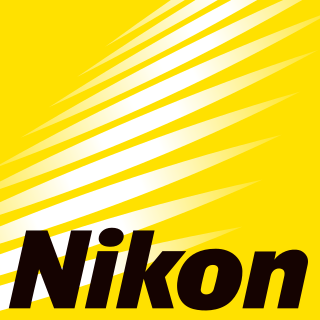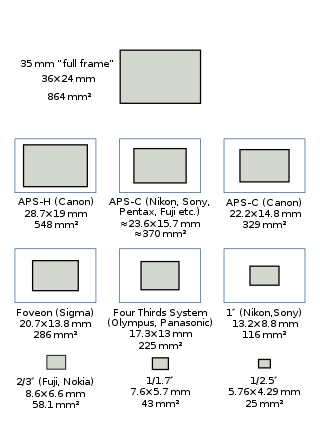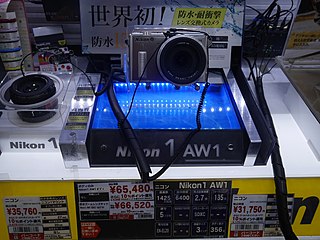
In photography and cinematography, a wide-angle lens refers to a lens whose focal length is substantially smaller than the focal length of a normal lens for a given film plane. This type of lens allows more of the scene to be included in the photograph, which is useful in architectural, interior and landscape photography where the photographer may not be able to move farther from the scene to photograph it.

Nikon Corporation, also known just as Nikon, is a Japanese multinational corporation headquartered in Tokyo, Japan, specializing in optics and imaging products. The companies held by Nikon form the Nikon Group.

A digital single-lens reflex camera is a digital camera that combines the optics and the mechanisms of a single-lens reflex camera with a digital imaging sensor.

Advanced Photo System type-C (APS-C) is an image sensor format approximately equivalent in size to the Advanced Photo System film negative in its C ("Classic") format, of 25.1×16.7 mm, an aspect ratio of 3:2 and Ø 31.15 mm field diameter. It is therefore also equivalent in size to the Super 35 motion picture film format, which has the dimensions of 24.89 mm × 18.66 mm and Ø 31.11 mm field diameter.

A full-frame DSLR is a digital single-lens reflex camera (DSLR) with a 35 mm image sensor format. Historically, 35 mm was one of the standard film formats, alongside larger ones, such as medium format and large format. The full-frame DSLR is in contrast to full-frame mirrorless interchangeable-lens cameras, and DSLR and mirrorless cameras with smaller sensors, much smaller than a full 35 mm frame. Many digital cameras, both compact and SLR models, use a smaller-than-35 mm frame as it is easier and cheaper to manufacture imaging sensors at a smaller size. Historically, the earliest digital SLR models, such as the Nikon NASA F4 or Kodak DCS 100, also used a smaller sensor.

The Nikon DX format is an alternative name used by Nikon corporation for APS-C image sensor format being approximately 24x16 mm. Its dimensions are about 2⁄3 those of the 35mm format. The format was created by Nikon for its digital SLR cameras, many of which are equipped with DX-sized sensors. DX format is very similar in size to sensors from Pentax, Sony and other camera manufacturers. All are referred to as APS-C, including the Canon cameras with a slightly smaller sensor.

In digital photography, the image sensor format is the shape and size of the image sensor.

The Nikon D700 is a professional-grade full-frame digital single-lens reflex camera introduced by the Nikon Corporation in July 2008 and manufactured in Japan. It uses the same 12.1-megapixel "FX" CMOS image sensor as the Nikon D3, and is Nikon's second full-frame digital SLR camera.

A mirrorless camera is a photo camera featuring a single, removable lens and a digital display. The camera does not have a reflex mirror or optical viewfinder like a digital single-lens reflex (DSLR) camera, but may have an electronic viewfinder. Many mirrorless cameras retain a mechanical shutter. Like a DSLR, a mirrorless camera accepts any of a series of interchangeable lenses compatible with its lens mount.
The Pentax Q series is a series of mirrorless interchangeable-lens cameras made by Pentax and introduced in 2011 with the initial model Pentax Q. As of September 2012, it was the world's smallest, lightest interchangeable lens digital camera. The first models used a 1/2.3" back-illuminated sensor CMOS image sensor. The Q7, introduced in June 2013, uses a larger 1/1.7" type sensor. The Q system is now discontinued.

The Nikon 1 series is a discontinued camera line from Nikon, originally announced on 21 September 2011. The cameras utilized Nikon 1-mount lenses, and featured 1" CX format sensors.

The Nikon 1 J1 is a Nikon 1 series high-speed mirrorless interchangeable-lens camera with 1" sensor size launched by Nikon on September 21, 2011. It is a new model that focuses on high-performance, portability and versatility. Nikon lists the estimated selling price of the Nikon 1 J1 One-Lens Kit in the United States at $649.95. Released on October 20, 2011, this kit comes with the 1 NIKKOR VR 10-30mm f/3.5-5.6 lens.

The Nikon 1-mount is a type of interchangeable lens mount developed by Nikon for its Nikon CX format mirrorless interchangeable-lens cameras. The 1-mount was first introduced on the Nikon 1 series in 2011, and features a bayonet mount.
The Nikon 1 J2 is a Nikon 1 series high-speed mirrorless interchangeable-lens camera launched by Nikon. Nikon lists the estimated selling price of the Nikon 1 J2 One-Lens Kit in the United States at $549.95. This kit comes with the 1 NIKKOR VR 10-30mm f/3.5-5.6 lens.

The Pentax Q is a mirrorless interchangeable-lens camera introduced by Pentax on June 23, 2011.
The Nikon 1 J3 is a Nikon 1 series high-speed mirrorless interchangeable-lens camera by Nikon. It is the successor of the Nikon 1 J2 and predecessor of Nikon 1 J4.

The Nikon 1 S1 is a Nikon 1 series low-cost high-speed mirrorless interchangeable-lens camera launched by Nikon. Nikon lists the estimated selling price of the Nikon 1 S1 One-Lens Kit in the United States at $499.95. This kit comes with the 1 NIKKOR 11–27.5mm f/3.5-5.6 lens. It features many similarities with the 1 J2, like the same 10.1 megapixel CX-format CMOS sensor and autofocus, but with an upgraded EXPEED 3A processor.

The Nikon 1 AW1 is a Nikon 1 series high-speed mirrorless interchangeable-lens camera by Nikon. It is a waterproof, rugged, high-speed MILC camera with 15 metres (49 ft) water pressure resistance, shockproof from 2 metres (6.6 ft), and freezeproof to −10 °C (14 °F). It was announced on September 19, 2013, together with two waterproof lenses.

The Samsung NX mini is a digital rangefinder-style interchangeable lens mirrorless camera announced by Samsung on March 19, 2014.
The 18-300mm f/3.5-5.6G ED VR is a telephoto superzoom lens manufactured by Nikon for its line of DX DSLR cameras.















